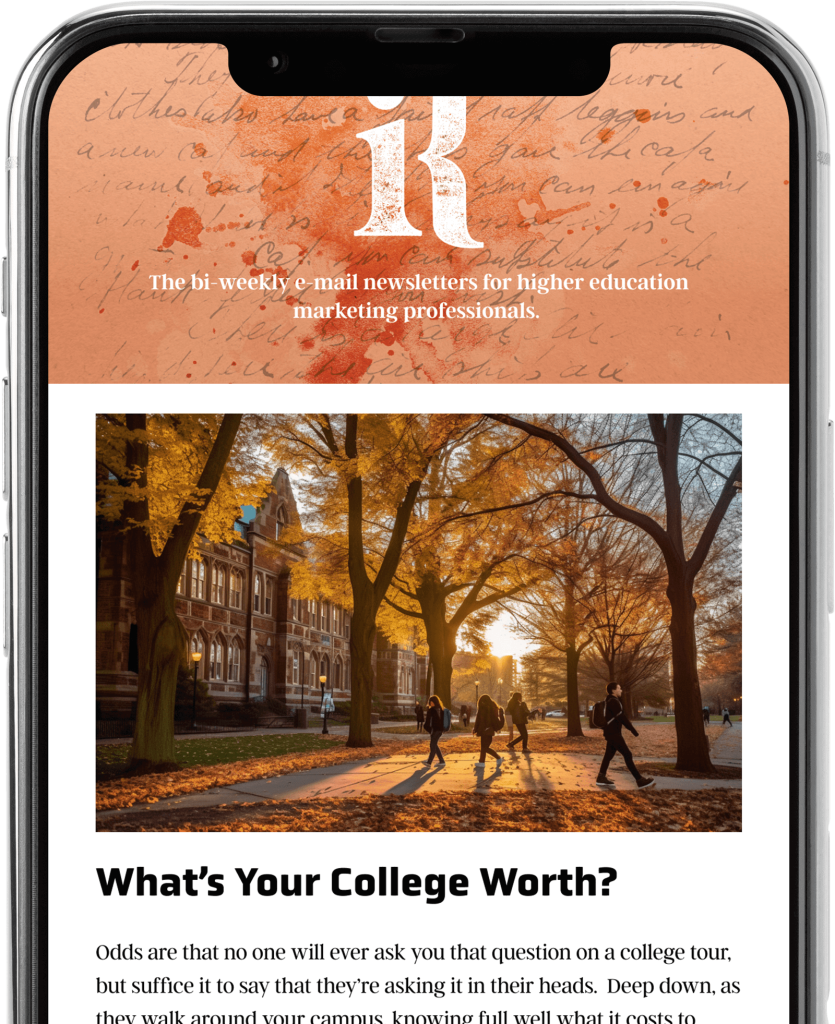Featured
The Higher Education Marketing Persona

Persona creation, in the realm of marketing, is like having a map that guides you directly to your customer’s needs and desires. It involves sketching out detailed profiles of ideal customers based on solid research and data from your current customers. These personas are more than just demographics; they’re a mix of motivations, pain points, behaviors, and dreams of a target audience.
Understanding an audience on a deeper level is the first major win of persona creation. Take Spotify, for example. They don’t just see their users as ‘music lovers.’ Their personas might include “The Workout Warrior” who needs pumping playlists for the gym or “The Commute Podcast Listener” looking for engaging stories on their way to work. By identifying specific needs and behaviors, Spotify can tailor its recommendations, making users feel seen and understood, thereby enhancing user engagement and loyalty.
Personas also are useful tools in organizing and unifying the various members of the organization in a marketing effort. Imagine a tech company developing a new app. By defining personas such as “The Tech-Savvy Professional” or “The Casual User,” the development, sales, and marketing teams can align their efforts. This ensures the app’s features and the marketing message cater precisely to what each user group values most, making the product more relevant and appealing.
Personas also make content resonate with more vibrance. Netflix is a master at this. They create content and recommendations that resonate with a wide array of personas, from “The Binge-Watcher” craving the next big series to “The Cinema Lover” seeking critically acclaimed films. This approach, powered by a technical engine of deep personalization, keeps content relevant and engaging, encouraging viewers to spend more time on the platform.
Further, personas can add leverage to a digital marketing strategy. Consider how a fashion brand might use personas like “The Trendsetter” seeking the latest styles or “The Bargain Hunter” looking for deals. These insights allow for more targeted ads and promotions, ensuring the brand reaches the right audience with the right message, boosting the effectiveness of their campaigns and ultimately driving sales.
The Collegiate Marketing Persona
Just like the example of the start-up restaurant catering to the high-end customer, your institution needs a persona or more (because sometimes an institution has multiple yet distinctive audience segments it serves) to reflect and codify a deep understanding of its core customer: the student who thrives at your institution. She refers her friends behind her in high school, contributes while on campus, graduates with flying colors, and then becomes a thriving (and contributing) alumnus. She represents your “right-fit” student or (RFS).
A persona can take many forms, but usually it’s a series of bullet points, illustrations, dimensional highlights, data points, and descriptors of your RFS. Although the particulars of your institution should drive the persona, there are some key dimensions that you should consider documenting when crafting the overview. They include some of the following as core elements:
- Hometown (geography) – Although this will certainly vary, it’s fair to say that the student who thrives at your college will have a geographic link or affiliation with your location. Although not true for all students or institutions, survey data suggests that more than 50% of graduating high school students attend college within 100 miles of their hometown. Data also suggests that 70% of high school graduates ultimately stay in-state. Documenting appropriate geographic considerations will help you to keep your eye on where your RFS comes from.
- Social climate – Students will inevitably be drawn to schools where they feel they can assimilate, find community, and fit in in some way. Anything that describes activities available when classes have ended for the day—whether it be Greek life, campus culture (yes, including the school’s after-hours atmosphere), or otherwise will help you develop the right connection. Highlighting the social disposition of your RFS is critical.
- Campus life – What does your RFS look for in terms of on-campus enrichment? Is she looking for big-time sporting events to attend? Or how about campus events where comedians, musicians, or authors visit to share their art? Perhaps your school is big on intramural sports, clubs, or athletics. Describing this in your persona is key.
- Off-campus interests – Similar to the geography considerations of a student’s hometown, it’s important to reflect the nature of your school’s location within your persona. Are you located in a rural, remote area? How about a densely populated urban area giving students a big-city feel? Are you near the beach, mountains, or extensive outdoor areas? Or perhaps you are located near special theme parks, museums, or learning institutes that cater to student interests. Reflecting these off-campus highlights in the persona of your RFS will help you steer marketing energy in that direction.
- Academic interests – Highlighting your institution’s academic programs in the persona of your RFS. If your institution is big on nursing, engineering, and accounting, those types of degree tracts are likely reflect in the persona of the student that thrives at your school. If highlighting specific programs aren’t necessary, highlighting things along the lines of disposition to learning
- Academic rigor – Is your institution considered difficult academically? Highlighting this dimension will not only help you attract the right student but also help with retention rates by avoiding students that sink—not swim—in your academic culture.
- Career aspirations – What does our student aspire to from a career standpoint? Do they typically come to us with a pre-disposed notion of what their career will look like or are they still exploring? Are they looking to immediately enter the workforce upon graduation or are they eyeing an post-graduate degree of some sort? Is there a specific target salary that influences their thinking?
- Financial mindset – How does our typical student view the financial arrangement in terms of value? Do they have special considerations regarding the support (or lack thereof) of their parents, disposition with respect to student debt, or expectations for return on investment (ROI)?
- Values alignment – What values are important to them as they seek to make their mark in the world? Do they have an orientation toward certain political or ideological views? Are their considerations of faith or social justice that shed light on our campus culture?
- Demographics – Include age, gender, location, and ethnicity. For colleges, you may also want to consider the type of high schools your prospective students are coming from (public, private, international).
- Challenges and Pain Points – What obstacles do they face in the application process? Are they worried about meeting admission requirements, the cost of education, or moving away from home? Addressing these concerns in your marketing materials can help your institution stand out.
- Communication Preferences – How do they prefer to receive information? This could include email, social media, webinars, in-person visits, or virtual tours. Tailoring your communication strategy to their preferences can improve engagement.
- Personality Traits – This can include whether they’re more introverted or extroverted, their level of independence, or their risk tolerance. These traits can influence how they perceive your marketing messages.
- Other – What other dimensions might you consider in crafting the persona of your RFS? Each institution’s persona will likely be unique in its format and presentation.
The figure below can serve as a template for how you might craft your institution’s persona.
Creating a marketing persona involves collecting and analyzing data from current students, surveys, interviews, and market research. The key questions to consider are these: what kind of student thrives here and what kind of student will thrive at the institution we are becoming? Remember, it’s beneficial to create multiple personas to represent the diversity of your prospective student body effectively. Each persona should guide tailored marketing strategies that address specific needs, preferences, and decision-making processes, ultimately making your marketing efforts more effective and personalized.
Like what you're reading?
Subscribe to our newsletter to get the latest insights in Higher Education and thought leadership.


